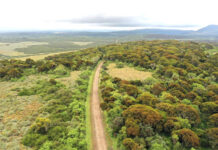By Julie Mulonga and Kariuki Ndang’ang’a
Nairobi, Kenya: For centuries, the phenomenon of bird migration has awed humanity. So much so, that the 4th Century BC Greek philosopher Aristotle, noting that the types of birds around him changed with the seasons, suggested that birds hibernated in trees or underwater and magically changed into different types of birds during winter. In the 17th Century, English scientist, Charles Morton wrote a paper claiming birds migrated to the moon and back every year.
These attempts to explain migration illustrate the keen interest humanity has taken in these birds as they travel thousands of kilometres on migration routes known as flyways, traversing continents in search of feeding, breeding, and resting grounds.

Africa is home to the African-Eurasian Flyway which is used by about two billion birds annually. Migratory birds play a critical role in our environment including pollination, controlling pests, in addition to economic benefits through birdwatching among others. Additionally, birds are good early warning systems of the planet’s health. Severe declines in bird numbers portend current and future threats, to biodiversity and people will face.
Every year, the world celebrates World Migratory Bird Day in May and October to raise awareness about this migratory species. This year’s theme Water: Sustaining Bird Life highlights the importance of water for the survival of these species. Migratory birds rely on water and habitats including wetlands for migration, breeding, and resting. Although they cover about 6% of the earth’s land surface area, wetlands are critical ecosystems, noting that about 40% of all plants and animal species live or breed in wetlands. Wetlands also play a crucial role in combating climate change, by absorbing huge amounts of carbon, providing essential ecosystem services like flood control and water regulation, in addition to supporting the livelihoods of more than one billion people across the world.
However, wetlands are disappearing at an alarming rate. It is estimated that the world has had about 35% percent of these critical ecosystems since the 1970s negatively impacting species including birds. Various factors including pollution, agriculture, and developments in addition to climate change threaten wetlands. In the Sahel region, for instance, Lake Chad, bordering Niger, Chad, Nigeria, and Cameroon has shrunk from 26,000 square kilometres in the 1960s to less than 1500 square kilometres today.
Thus, protecting and restoring these important sites for migratory birds is critical. One of the ways through which this can be done is through collaborations and partnerships. A good example of this is in Asia’s East Asian Australasian Flyway stretching from Siberia and Alaska to New Zealand and Australia, where BirdLife in collaboration with the Asian Development Bank (ADB) and the East Asian Australasian Flyway Partnership Secretariat (EAAFP), launched a $3 billion Regional Flyway Initiative (RFI) in 2021. The initiative aims at the protection and restoration of more than 50 key wetlands sites along the Flyway which are important sites for millions of migratory birds, in addition to supporting the livelihoods of millions of people through fisheries and agriculture among others. Such models can be replicated across flyways, benefitting nature and people.
Equally important is the need for concerted efforts from various stakeholders including local communities, and policy and decision-makers to identify and implement relevant solutions to conserve these critical habitats. Migratory birds and wetlands connect countries, and their conservation will require cooperation and coordination across national boundaries.
As we celebrate World Migratory Bird Day on 13th May 2023, let us renew our efforts to protect migratory birds and wetlands for future generations.
Julie Mulonga is the Director – Wetlands International Eastern Africa, and Dr. Kariuki Ndang’ang’a, Africa Regional Director, BirdLife International.














